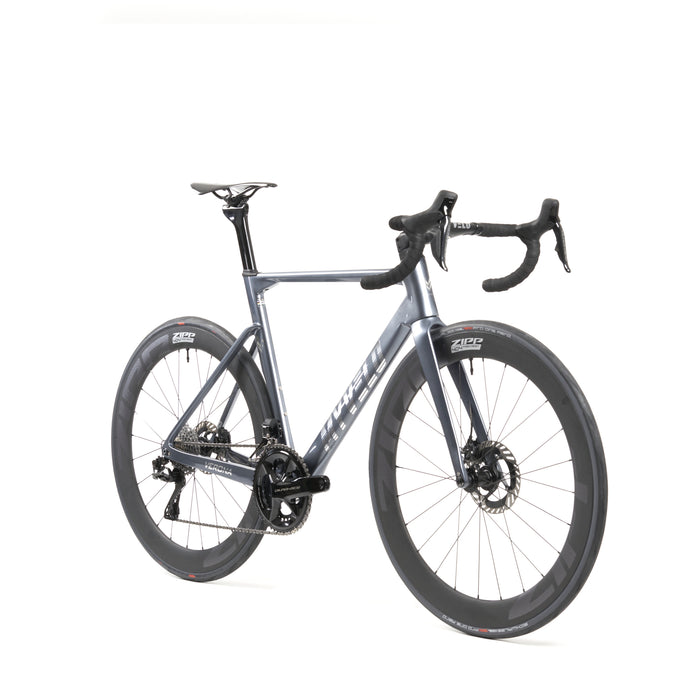
Verona road bike
incl. FREE shipping & free returns

Von Lukas Vogt |
3 minutes read time

Now that you understand what VO2Max is and why it is so important for your performance on the road bike, it is now time to look at how you can specifically improve this crucial metric.
When it comes to improving VO2Max, interval training is probably the most effective method. Particularly intense intervals (such as high intensity interval training, HIIT) push your maximum oxygen uptake to the limit and promote your aerobic capacity. With interval training, you alternate between phases of maximum exertion and short recovery phases. This method quickly gets your pulse up to full speed, which sustainably increases your VO2Max.
You can incorporate this training into your training plan 1-2 times a week to work specifically on your VO2Max. Make sure that you really push yourself to the limit during the intensive phases, as this is the only way to achieve the maximum effect.
In addition to interval training, it is important to complete intensive sessions regularly. Your cardiovascular system adapts to the strain, and the more often you challenge it, the better it will be at absorbing oxygen. In addition to the classic intervals, you should also integrate long rides into your training plan. These increase your basic endurance and improve your overall aerobic capacity.
A good mix of short, intense sessions and longer, moderate rides is the key. This is what a typical weekly plan might look like:
Patience is a virtue when it comes to improving VO2Max. You won't see significant improvements overnight, but with consistent training, you'll see results in about 6 to 8 weeks.
It also depends on your current training level. Beginners or those returning to cycling can see progress more quickly, while experienced riders have to work harder to achieve small improvements. It is important that you continually adapt your training and regularly work on your VO2Max without falling into overtraining.
An often overlooked factor in improving VO2Max is proper nutrition and adequate recovery. Your body not only needs training, but also the right nutrients to recover and adapt to the strain.
Nutritional tips to support VO2Max increase:
Hydration is also crucial. Even slight dehydration can affect your VO2Max and performance. Make sure you drink enough before, during and after training, especially on hot days or during intense sessions.
In addition to nutrition, recovery plays a crucial role. After intensive sessions, your body needs time to regenerate and adapt. Without sufficient recovery, you not only risk injury, but also prevent the training effect.
Therefore, plan regular rest days and pay attention to the signals from your body. If you feel constantly tired and exhausted, you should reduce the intensity for a few days. Active regeneration such as easy rides or light stretching can help to get your body back up to speed more quickly.
Improving your VO2Max is a long-term process that requires regular and intensive training. Interval training and long rides are the most effective ways to maximize your oxygen uptake. But don't forget: nutrition and recovery also play an important role in getting the most out of your training.
Stick with it, be patient and work continuously on your VO2Max - this will take your road bike performance to a new level in the long term. In the next article in this series, you will learn how to measure your VO2Max and optimally track your progress!

Wer regelmäßig mit dem Rennrad unterwegs ist, kennt das Ritual: Nach einer langen Ausfahrt oder vor einem knackigen Intervalltraining führt kein Weg am Espresso vorbei. Ob in der italienischen Bar an der Strecke, auf dem Marktplatz nach dem Sonntagstraining oder zuhause aus der Siebträgermaschine – der Espresso ist fester Bestandteil der Rennradkultur. Doch was steckt hinter dieser Verbindung aus Koffein, Stil und Leistung?

Wer an Rennradfahren denkt, hat oft Bilder von durchtrainierten Beinen, kraftvollen Antritten und aerodynamischer Haltung im Kopf. Doch ein Muskel spielt eine unterschätzte, aber entscheidende Rolle: der Beckenboden. Er ist nicht nur für Stabilität und Körperkontrolle wichtig, sondern auch für Komfort, Leistungsfähigkeit – und die langfristige Gesundheit auf dem Rad.

Die Auswahl an Fahrrädern war noch nie so groß wie heute. Rennrad, Mountainbike oder doch ein Gravel Bike? Jedes dieser Bikes hat seinen eigenen Charakter, seine Stärken und idealen Einsatzbereiche. Doch wo liegen die Unterschiede – und welches Rad passt am besten zu Dir und Deinem Fahrstil? In diesem Artikel erfährst Du, was die drei Bike-Typen auszeichnet, welche Vor- und Nachteile sie haben und worauf Du bei der Entscheidung achten solltest.